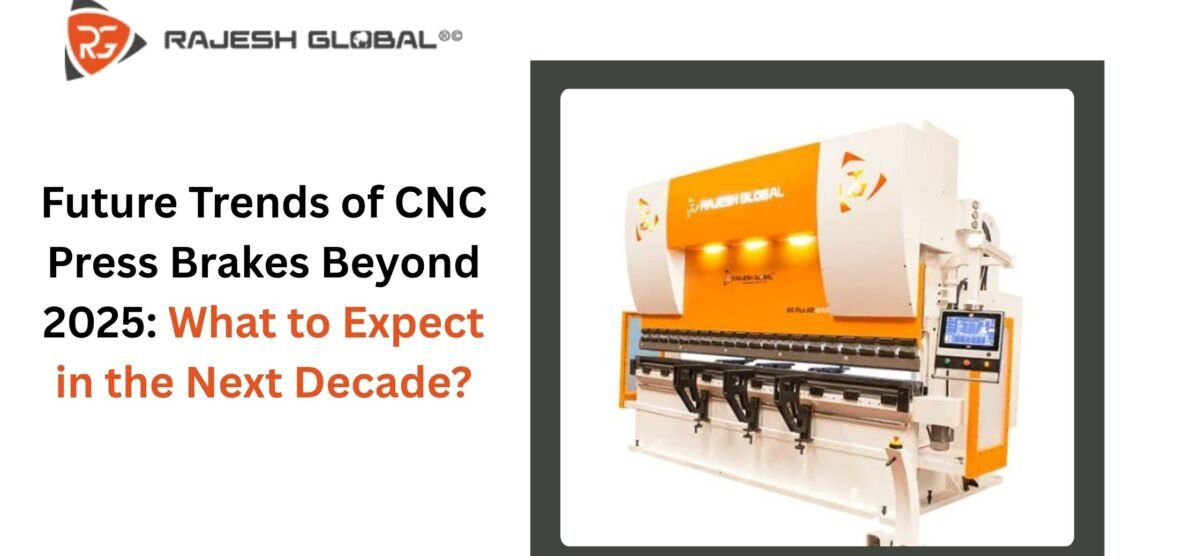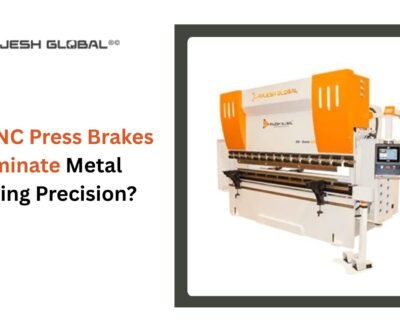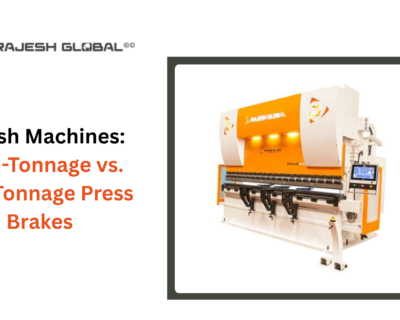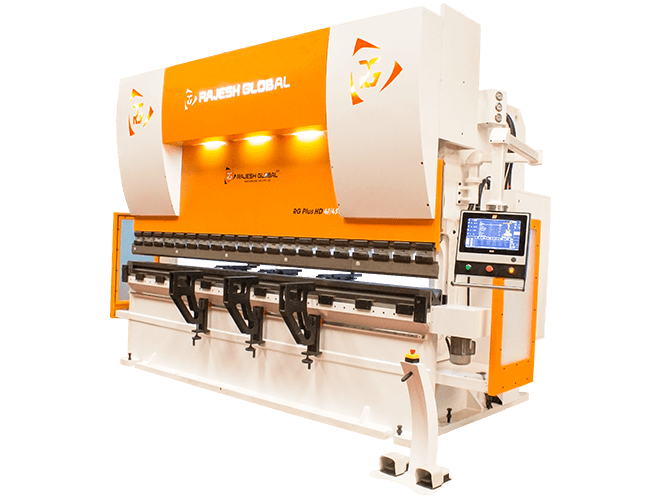Blog

Future Trends of CNC Press Brakes Beyond 2025: What to Expect in the Next Decade?
Since their debut in the late 1970s, CNC press brakes have rewritten the rules of metal fabrication. What began as a leap from manual bending to programmable control has now become the backbone of advanced manufacturing. The shift to CNC—Computer Numerical Control—was more than a technical upgrade; it was a reimagining of what’s possible in precision, repeatability, and efficiency. Today, these machines are indispensable in industries ranging from aerospace to medical devices, where “greater precision, efficiency, and automation” are not just perks, but requirements. The next decade promises to be even more transformative, as CNC press brakes stand at the intersection of digital intelligence, automation, and sustainability.
Foundations: How CNC Press Brakes Work and Their Impact on Sheet Metal Fabrication
Contents
- 1 Foundations: How CNC Press Brakes Work and Their Impact on Sheet Metal Fabrication
- 2 The State of the Art in 2025: Current Technologies, Market Dynamics, and Industry Benchmarks
- 3 Automation and Robotics: The Next Leap in Productivity and Flexibility
- 4 Artificial Intelligence and Smart Manufacturing: Toward Self-Optimizing Bending Solutions
- 5 Energy Efficiency and Sustainability: Designing Greener Press Brake Systems
- 6 Advanced Materials and Adaptive Bending: Meeting Tomorrow’s Fabrication Challenges
- 7 Digital Integration: Industry 4.0, IoT, and the Rise of Connected Manufacturing
- 8 Safety, Ergonomics, and Workforce Transformation: Human-Centric Innovations
- 9 The Competitive Landscape: Global Market Shifts, Investment Opportunities, and Regional Growth
- 10 Rajesh Machine Tools Pvt. Ltd.: Pioneering Innovation and Excellence in CNC Press Brakes
- 11 Vision 2035: Strategic Roadmap and Future-Ready Solutions for the Next Decade
- 12 Conclusion: Embracing Change—How Forward-Thinking Manufacturers Will Lead the CNC Press Brake Revolution
At their core, CNC press brakes use programmable logic to control the position, force, and sequence of bends in sheet metal. Unlike their manual predecessors, which depended heavily on operator skill and intuition, CNC machines execute intricate bends with computer-guided accuracy. This leap has “eliminated costly errors, reduced scrap, and ensured products consistently meet the highest quality standards.” The result is a dramatic reduction in rework, faster lead times, and a new standard for quality control.
But the story doesn’t stop at precision. CNC press brakes have unlocked new product possibilities—complex geometries, tighter tolerances, and innovative designs that were once out of reach. In the words of one industry leader, “CNC Press Brakes are not just about bending metal; they are about expanding your fabrication capabilities and unlocking new product possibilities.” This foundation sets the stage for a decade of unprecedented innovation.
The State of the Art in 2025: Current Technologies, Market Dynamics, and Industry Benchmarks
By 2025, the global press brakes market is accelerating at a CAGR of 4.7%, projected to add $463.5 million in value by 2029. The electric segment alone was valued at over $225 million in 2023 and is growing even faster, thanks to its “superior energy efficiency, precision, and reduced maintenance costs.” Automated and CNC-equipped machines are now the industry standard, enabling manufacturers to manage intricate designs with minimal material waste and maximum productivity.
The market’s growth is fueled by surging demand for fabricated metal products, especially in automotive, construction, and infrastructure. Vendors are racing to integrate IoT, develop robotic arms, and experiment with 3D-printed press brake tools. As one recent report notes, “The incorporation of press brakes with IoT is one of the prime reasons driving the press brakes market growth during the next few years.”
Automation and Robotics: The Next Leap in Productivity and Flexibility
Skimmable Section
- Robotic Integration: Modern press brakes are increasingly paired with robotic arms for loading, unloading, and tool-changing. This not only increases throughput but also slashes downtime, allowing machines to run longer with less human intervention.
- Collaborative Robots (Cobots): The rise of cobots means safer, more flexible automation. These robots can work alongside human operators, assisting with material handling, quality checks, and even adaptive bending.
- 24/7 Production: Automation enables true lights-out manufacturing—press brakes that run around the clock, maximizing output and minimizing labor costs.
- Real-World Impact: Fabricators report up to a 40% increase in productivity after automating their press brake operations, with some achieving ROI in under two years.
Artificial Intelligence and Smart Manufacturing: Toward Self-Optimizing Bending Solutions
Artificial Intelligence is not just a buzzword—it’s rapidly becoming the brains behind the brawn. AI-powered press brakes can now analyze data in real time, adjusting bending force, speed, and angle based on material thickness, type, and even machine health. “AI integration in press brakes enhances precision, productivity, and maintenance practices,” as one leading manufacturer puts it.
These smart systems detect anomalies before they become defects, reducing waste and improving first-pass yield. Operators can visualize the bending process on a screen, making it easier to spot and correct errors before they occur. The ultimate goal? Self-optimizing machines that learn from every bend, continuously improving without human intervention.
Energy Efficiency and Sustainability: Designing Greener Press Brake Systems
The next decade will see a decisive shift toward sustainability. Electric press brakes, which use servo-driven motors instead of hydraulics, are leading the charge. They consume up to 30% less energy, require less maintenance, and operate more quietly—making them “an ideal choice for industries prioritizing sustainability and efficiency.”
Green manufacturing is more than a trend; it’s a competitive advantage. Companies are seeking machines that not only reduce operational expenses but also align with global environmental standards. Expect to see more press brakes with energy recovery systems, eco-friendly lubricants, and recyclable components as regulatory and market pressures mount.
Advanced Materials and Adaptive Bending: Meeting Tomorrow’s Fabrication Challenges
The materials landscape is evolving fast. Modern press brakes must handle everything from mild steel and stainless to exotic alloys like titanium and Inconel. Each material brings unique challenges—aluminum, for example, is prone to cracking, while high-strength steels demand higher tonnage and specialized tooling.
Adaptive bending technology is rising to meet these challenges. With real-time monitoring and feedback loops, press brakes can automatically adjust parameters to ensure flawless bends, regardless of material variability. “Modern press brakes can handle many different materials, making them versatile tools for metal fabrication,” says one expert. This versatility is opening doors to new applications in aerospace, medical devices, and beyond.
Digital Integration: Industry 4.0, IoT, and the Rise of Connected Manufacturing
Skimmable Section
- Industry 4.0 Connectivity:Press brakes are becoming nodes in a digital ecosystem, communicating with other machines, ERP systems, and cloud platforms.
- IoT Sensors: Real-time data collection enables predictive maintenance, reducing unplanned downtime and extending machine life.
- Remote Monitoring and Control: Operators and managers can oversee and adjust press brake operations from anywhere, using mobile devices or web dashboards.
- Data-Driven Decisions: Analytics tools turn production data into actionable insights, driving continuous improvement and smarter resource allocation.
Safety, Ergonomics, and Workforce Transformation: Human-Centric Innovations
As automation and intelligence increase, so does the focus on safety and ergonomics. Modern press brakes are equipped with advanced safety systems—light curtains, laser scanners, and emergency stop protocols—that protect operators without sacrificing productivity.
Ergonomic design is reducing operator fatigue and injury, making press brake operation accessible to a wider workforce. Meanwhile, the nature of work is changing: operators are becoming programmers and process optimizers, while robots handle the heavy lifting. As one industry analyst puts it, “The future of manufacturing belongs to those who can blend human ingenuity with machine precision.”
The Competitive Landscape: Global Market Shifts, Investment Opportunities, and Regional Growth
The global press brake market is fiercely competitive, with major players like Amada, Bystronic, Trumpf, and Rajesh Machine Tools Pvt. Ltd. pushing the envelope on innovation. Asia-Pacific is emerging as a powerhouse, driven by infrastructure investment and a booming automotive sector. North America and Europe remain strongholds of advanced manufacturing, with a focus on automation and sustainability.
Investment in press brake technology is not just about capacity—it’s about capability. Companies that invest in smart, connected, and sustainable machines are better positioned to capture new markets and respond to shifting customer demands.
Rajesh Machine Tools Pvt. Ltd.: Pioneering Innovation and Excellence in CNC Press Brakes
Rajesh Machine Tools Pvt. Ltd. stands at the vanguard of this revolution. With a legacy of “offering cutting-edge solutions that meet the growing demands for precision and efficiency in metal fabrication,” Rajesh integrates advanced hydraulic and CNC technologies to deliver high performance, reliability, and energy efficiency.
The company’s focus on automation and smart controls—such as real-time monitoring, AI-driven optimization, and robotic integration—ensures that clients are equipped for the challenges of the next decade. Rajesh’s machines are designed for versatility, catering to industries from automotive to construction, and are renowned for their reduced downtime and adaptability.
Vision 2035: Strategic Roadmap and Future-Ready Solutions for the Next Decade
Looking ahead, the vision for CNC press brakes is clear: smarter, greener, and more connected. Expect to see:
- Self-learning machines that optimize every bend
- Universal compatibility with digital manufacturing platforms
- Press brakes that adapt instantly to new materials and product designs
- Seamless integration with AI-powered quality control and logistics systems
Rajesh Machine Tools Pvt. Ltd. is committed to leading this charge, investing in R&D, customer support, and global partnerships to ensure their clients stay ahead of the curve.
Conclusion: Embracing Change—How Forward-Thinking Manufacturers Will Lead the CNC Press Brake Revolution
The next decade will not belong to those who stand still. The winners will be the manufacturers who embrace automation, intelligence, and sustainability—who see every bend as an opportunity for innovation. As one expert observed, “Press brakes have come a long way from their humble beginnings; the future is about continuous evolution, driven by smarter controls, automation, and energy efficiency.”
For entrepreneurs and industry leaders alike, the message is clear: invest in the future, partner with innovators like Rajesh Machine Tools Pvt. Ltd., and be ready to shape the next era of metal fabrication. The revolution is already underway—are you ready to bend the future to your will?






